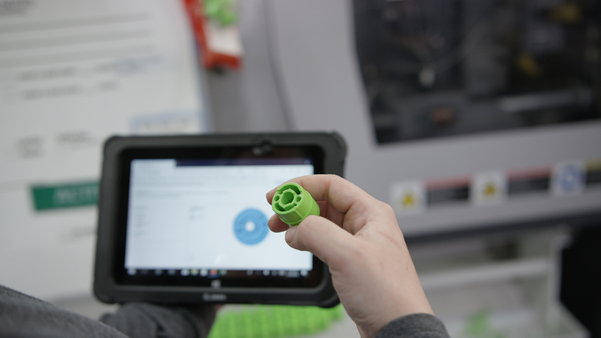Using First Article Inspection (FAI) for Part Quality, Consistency at Speed

There are many ways manufacturers use quality control measures to achieve the high standards requested for certain parts. Inspection, testing, and sometimes even corrective actions are necessary to eliminate defects, and validate that parts are consistent run-to-run, also that the parts are safe, function as expected, and comply with regulations, no matter the industry.

We use digital manufacturing which can include scientific molding processes, combined with specific quality assurance and control methods, to produce parts rapidly and consistently. Our standard quoting process provides design for manufacturability (DFM) analysis, a first step to ensuring a quality molded part. We measure up to four plane-to-plane and outside diameter dimensions based on your CAD model (X, Y, Z) to quoted tolerances. In addition to our standard process, we offer a broad range of quality measurement, inspection, and documentation options to ensure rigorous standards for delivering high-quality injection molded parts.
That range of inspection report options includes measurement methods such as our partial First Article Inspection (FAI), Production Part Approval Process (PPAP), Critical-to-Quality Inspection (CTQ), and Digital Inspection Reports (DIRs), available at time of purchase. This blog post takes a closer look at that first one, FAI for molded parts. As always, you can consult with one of our injection molding experts to decide which inspection options are best suited for your project needs.
What is FAI?
First Article Inspection (FAI) involves a quality inspection of parts conducted with calibrated or certified measuring equipment that assesses one or several parts taken at random from the beginning of a production run. This ensures the parts meet the customer’s specifications.
FAI emerged during World War II as a response to the demand for precision and uniformity in aerospace and defense manufacturing. FAI has since integrated key technological innovations, including digital and software tools such as computer-aided design and computer-aided manufacturing (CAD and CAM), which have significantly advanced how inspections are conducted.
These days, depending on the manufacturer, the number of parts and dimensions measured will vary. We do a partial FAI, which allows measuring up to 10 parts and 25 dimensions, usually assessing those critical parts that are key to the product’s function or have been changed since the last inspection. It’s called a partial FAI because some manufacturers will inspect more parts, dimensions, and additional requirements, though those evaluation processes require considerably more time to conduct. As a digital manufacturer, we work with companies that come to us for quick-turn production. As a result, we commit to accelerating customers’ parts production. Our FAI process safeguards speed while also ensuring part quality and consistency.

What is the FAI Process?
In general, the FAI process includes several steps, varies by manufacturer, and can involve a range of elements such as design reviews, defining the scope of an inspection, documenting results, and other aspects.
We start defining the scope of the inspection process by creating an Inspection Statement of Work (ISOW). We then create or prepare inspection fixtures, tools, and equipment, as needed, such as gauges and CMMs (Coordinate Measuring Machines), all of which are certified or calibrated to achieve precise measurements. The parts that are chosen for the FAI evaluation are then inspected, and following that step, we document the results of the inspection.
One item to note: if a customer wants more than what’s available with our partial FAI, we work with a trusted inspection partner. Ask your Protolabs applications engineer about additional inspection opportunities.
Which Industries Use FAI?
Most industries use some level of FAI as an inspection option, in addition to other available quality assurance methods. We get many requests from the automotive, aerospace, medical, and consumer electronic industries.
The automotive industry often uses FAI especially when introducing new parts or making design changes or other modifications to existing parts.
The aerospace sector requires FAI for each new part or assembly before manufacturing begins.
The medical industry finds FAI to be pivotal for meeting compliance standards. Industry sources say that it can help medtech and medical device companies meet regulatory requirements and, overall, can help ensure quality, safety, and compliance.
Consumer electronics companies look to FAI before mass production of new products to make sure all specifications have been met and to validate that all components and assemblies function as expected.

What are the Benefits of Using FAI?
Several notable benefits of requesting Protolabs FAI include:
Speed
This is the key benefit. With automation behind all of our processes and capabilities, FAI at Protolabs allows for an efficient FAI method, completing critical feature inspections rapidly without affecting a part’s production lead time. Our process allows for quality and consistency at speed. That leads to the next benefit.
Consistency
The FAI evaluation at Protolabs verifies part consistency from run to run.
Evidence of meeting requirements
FAI helps companies meet compliance, regulatory, and other standards. The FAI assessment, through its documentation, includes evidence of that.
Early detection of part defects
Doing inspections at the beginning of a production cycle can help our customers circle back and iterate alternative designs to make the part manufacturable.
Save money, reduce waste
Related to early detection of defects by identifying potential design or other issues early in production, FAI can save money and resources and reduce waste.

What are Common Challenges of FAI?
Product designers and engineers can potentially face plenty of challenges with inspection processes in general: part complexity, documentation complexity, time constraints such as meeting production deadlines, change management (dealing with design changes or specifications during production phases), and more.
Our automated processes and capabilities have solved many of these challenges. For example, our own proprietary manufacturing execution software (MES) system can especially help with time constraint issues, change management challenges, and overall costs.
Ultimately, companies turn to Protolabs for rapid prototyping and accelerated manufacturing through the product life cycle. Accordingly, our inspection processes reflect that quick-turn approach, completing part inspections rapidly without affecting a part’s production lead time, quality and consistency—in other words, quality and consistency at speed.
If you have more questions about FAI, or any other quality inspection methods that we offer, contact one of our applications engineers at customerservice@protolabs.com or 877-479-3680.








